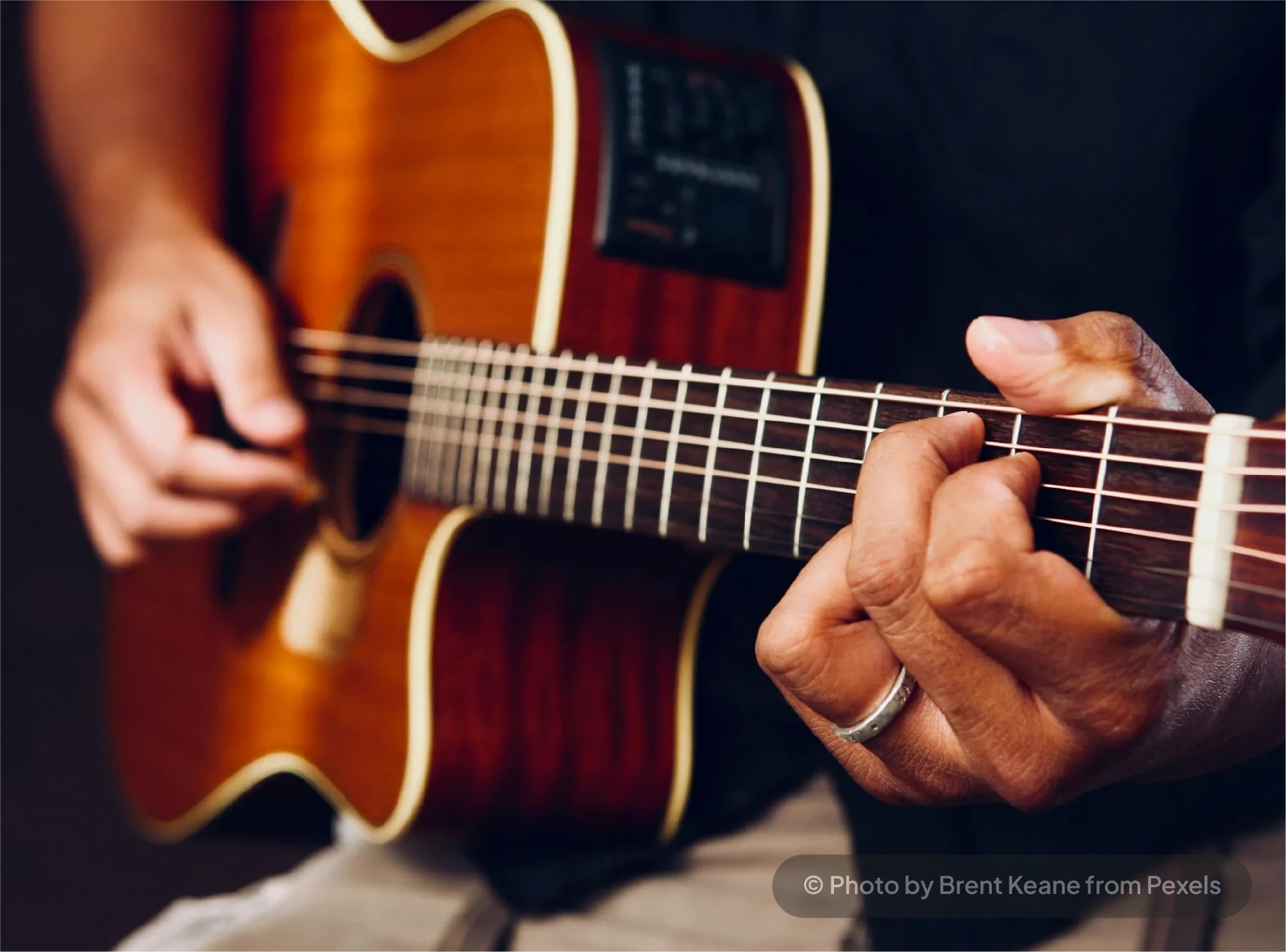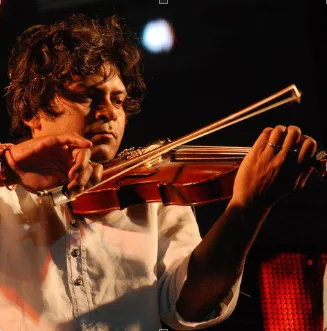Violin vs Guitar: 6 Differences Between a Violin and a Guitar
Have you ever wondered what makes a violin and a guitar so unique? Although both use strings to produce music, the way they’re played, their sound, and their role in music couldn’t be more different. This blog will help you understand the main differences between the violin and guitar so you can decide which suits you best. Let’s dive into their fascinating differences and see which one strikes the right chord with you.
6 Differences Between Violin and Guitar
1. Design & Physical Structure
When you take a first look at both instruments, it may appear similar because both instruments belong to the string family. But that is where the similarities end. The distinction between the violin and the guitar begins with their design. The violin is a four-stringed, small, fretless instrument that is often played with a bow. It is held between the shoulder and chin, a position specific to bowed string instruments.
The guitar, on the other hand, has a bigger body, six strings, and frets along the fingerboard. Guitars can be acoustic or electric, flat-topped or arched, and are often played on the lap or strapped to the shoulder. Unlike violins, which require the development of intonation through ear and muscle memory, guitars have frets, which simplify note placement for beginners by clearly marking finger positions.
This significant distinction between the guitar and the violin influences the learning curve and accessibility of each instrument.
2. Sonic Identity and Playing Technique

The sound of the violin and guitar is the main factor that actually reveals their unique personalities. The violin, when played with a bow, generates a continuous, stretched tone. It has a broad expressive range and imitates the human voice with grace and emotion. Its tone is more lyrical, making it ideal for melodies and solo performances, particularly in classical and Indian classical music styles.
The guitar, whether strummed or plucked, has a percussive and rhythmic sound. If the sound is not electrically sustained, it decays naturally after each note is struck. Guitars are also built to play chords quickly, making them perfect for accompanying singers or performing harmonic progressions. This difference in sound, sustained and rhythmic, defines the violin vs guitar sonic experience.
3. Musical Roles and Genres
One of the most notable differences between the violin and the guitar is the musical roles they play. The violin has strong roots in classical music. It's a standard in orchestras, small ensembles, and solo performances. It also plays an important role in Indian classical music, both Carnatic and Hindustani, where it aligns well with the raga system.
In contrast, the guitar is a genre chameleon. It fits well with rock, blues, pop, jazz, flamenco, country, metal, and reggae, among other genres. The guitar is used everywhere, from rock stars on stage to street buskers. It is especially important in composing because it can play both melody and harmony at the same time. So, while the violin is often a lead melodic instrument, the guitar is frequently used as both a rhythm and harmony instrument. This is one difference between the violin and the guitar that has a significant impact on where and how each instrument is played in the musical world.
4. Is Violin Harder Than Guitar?

Let us answer this basic question directly: Is the violin harder than the guitar? The short answer is yes, especially at the beginning. A beginner faces numerous challenges when learning to play the violin. Because there are no frets and students need to develop a keen ear for pitch. Producing a clean tone with the bow demands precise coordination and technique, and learning posture and intonation takes time. Many people have to wait months before they can comfortably play a tune that sounds well.
On the other hand, the guitar provides a more flexible beginning. With frets and chord charts, a beginner can strum simple songs in a few weeks. It's easy to pick up and self-teach the guitar in the beginning stages. However, the difficulty ratio between the guitar and the violin eventually balances out. While violinists struggle early on, guitarists face serious challenges when exploring techniques such as barre chords, fingerpicking, and solo improvisation.
In the end, both instruments are tough in their own way; it just depends on where and how you measure that difficulty.
5. Technique and Finger Use
The coordination of the fingers and hands is another significant distinction between the violin and the guitar. Violinists use their left hand to press strings on the fingerboard, while their right hand controls the bow. The bowing technique itself can take years to master because tone quality is influenced by the bow's pressure, speed, and angle. Violinists go to advanced stages when they learn vibrato, shifting, and double stops, all of which need subtle control.
Guitarists, on the other hand, press down the frets with one hand while plucking or strumming with the other. While no bowing is required, guitar players have to learn strumming patterns, picking techniques, and fingerstyle techniques. Electric guitarists also use slides, bends, and tapping in their toolkit. The guitar allows for greater rhythmic variety, but the violin focuses on graceful phrasing and tone purity. So the conclusion is that each instrument poses distinct challenges based on the genre and level of proficiency. One cannot say which one is harder to learn.
6. Solo Versus Ensemble Roles
In performance, both instruments play quite different roles. The violin is frequently the focal point in solo performances or the primary voice in orchestral arrangements. It weaves melodic lines and frequently conveys emotional themes, especially in classical songs.
Meanwhile, the guitar has become more popular in groups, bands, and to accompany singers. It can lead or assist, and its ability to play both chords and melody makes it extremely adaptable in group situations. While solo guitar performances are widespread, particularly in the flamenco and fingerstyle genres, pop and rock songs rely heavily on rhythm and harmony. This distinction between guitar and violin reflects their conflicting musical identities: one as a lyrical voice, the other as a rhythmic backbone.
Wrap Up - Violin vs Guitar
Choosing between violin and guitar is more than just a matter of ease or popularity. It's about connection, what sound appeals to you, what genre inspires you, and what type of musical adventure you're ready to embark on. Whether you prefer the passionate bowing of a violin solo or the frenetic strumming of a guitar riff, each instrument adds its own charm to the world of music.
The difference between the violin and the guitar is more of a celebration of diversity than a competition. So, whether you're comparing the guitar and violin difficulty or simply curious about what distinguishes them, keep in mind that both can change your life in beautiful, unexpected ways. Do you want to learn to play guitar or violin? Explore online guitar classes and online violin lessons.
Generally, guitar can be more initially painful than violin due to the pressure needed to hold down steel strings, especially for beginners learning chords. However, violin can cause more sustained pain in the neck, back, and arms due to its posture and awkward playing position, especially with extended practice.
No, the violin is generally considered one of the most difficult instruments to learn.
The guitar is older than the violin.
The violin is widely considered one of the most challenging instruments to learn and master, due to its complex techniques and unforgiving nature.
Generally, the guitar is considered easier to learn than the violin, especially for beginners.














